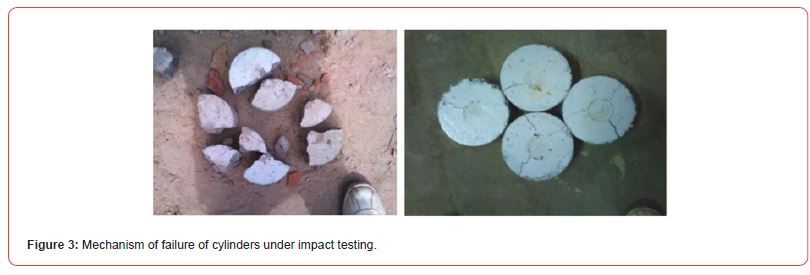 Review Article
Review Article
Fiber-Reinforced Concrete-A Comprehensive Review
Abdallah S. Elgharbawy*
Department of Materials Science, Alexandria University, Egypt
Materials Science Department, Institute of Graduate Studies and Research (IGSR), Alexandria University, 163 Horrya Avenue, P.O. Box 832, Shatby , 21526 Alexandria, Egypt.
Received Date: April 21, 2023; Published Date: May 09, 2023
Abstract
Concrete is the most multilateral material used for building and construction activities. Pure concrete is an easy material to be broken and it has low flexibility, ductility, tensile strength, and strain value. Small cracks or micro cracks that exist in concrete lead to fracture. Therefore, the presence of distributed fiber is to bridge across the cracks to provide post-crack ductility. When the fibers are adequately strong and linked to the material, the concrete will make significant stress over the large strain the post cracking stage. In addition, the main hurdle to the commercialization of concrete is its high sale price. The global trend now is to produce fiber-reinforced concrete that is characterized by low cost and a considerable productivity.
Keywords: Fibers; Concrete; Fiber-reinforced concrete
Introduction
Fiber reinforced concrete (FRC) is a concrete containing a water, hydraulic cement, and distributed fibers [1]. Fibers can be in form of steel fiber, glass fiber, natural fiber (asbestos, cellulose) or are a manufactured product such as glass, steel, carbon, and polymer, synthetic fiber. The quantity of fibers used is small, typically 1.0- 5.0 % by volume [2]. The crucial aim of fibers is to link or connect the gaps that spread in concrete to raise the flexibility and ductility of the concrete. The modification on post-cracking attitude of concrete provides more impedance to the impact strength. Controlling the plastic compression cracking and drying shrinkage cracking decreases the permeability of concrete matrix; therefore, reducing the water leakage [3,4]. Adding 0.8 wt. % of plastic improves the strength recorded. Thus, it is concluded that the use plastic can possibly increase the tensile strength of concrete [3,5]. The use of plastic can improves the properties of concrete that is considered a plastic disposal method. Figures 1, 2, and 3 shows the mechanism of concrete failures under different tests (Figures 1, 2, and 3).



Fibers Types used in FRC
1) Steel Fiber
2) Polypropylene Fiber
3) Glass-Fiber
4) Asbestos fibers
5) Carbon fibers
Steel fiber
• Steel fiber are of different shape and size.
• Steel fiber is the most known used fibers.
• Steel fiber has an elevated tensile and compression strengths.
Application of SFRC :-
• Airport Pavements
• Tunnel Lining
• Bridge Deck Slab repairs, and so on
Natural fiber:
• Natural Fibers is inexpensive and renewable substitute to the metallic and synthetic fibers in the building materials.
• When natural fiber is used in construction activities, it costs a very little value.
• Natural Fibers is used in cheap concrete ingredients as a reinforcement material that used in tropical earthquake regions.
Artificial fiber
• Synthetic Fibers are produced from manmade elements that can resist the long term alkaline environment of concrete -[6].
• It is made from synthesized polymers.
• The components used to fabricate these fibers made from feedstocks such as petroleum and chemicals.
Advantages of Nylon Fiber :-
• The contract of concrete cracking is due to the plastic shrinkage [7].
• Decrease the concrete permeability.
• Areas that needs both alkali proof and chemical resistant materials.
Glass fiber
• It is manufactured from very fine glass fibers.
• Glass Fiber is a lightweight, extremely strong, and robust material.
Uses of Glass Fiber:-
• Rolls twine around missile casingsExhaust nozzles
• Heat shields for aeronautical equipments
• Wall paneling
• Boat hulls and seats
• Fishing rods
Conclusion
The energy absorption capacity absorbed in fiber-reinforced concrete is 40 times more for than that of pure concrete. Adding fiber increases the strength and decreases the cracks. At high temperature, FRC have more strength in both compression and tension
Acknowledgement
None.
Conflict of Interest
No Conflict of interest.
References
- Cerri BC, LM Borelli, IM Stelutti, MR Soares, MA da Silva (2020) Evaluation of new environmental friendly particulate soil fertilizers based on agroindustry wastes biopolymers and sugarcane vinasse. Waste Management 108: 144-153.
- Abdallah SE (2021) A Review on Phthalic Anhydride Industry and Uses. Ann Petro Petrochem eng 1(1): 1-2
- El-gharbawy A, W Sadik, O Sadek, M Kasaby A (2021) review on biodiesel feedstocks and production technologies. Journal of the Chilean Chemical Society, 66(1): p. 5098-109.
- Elgharbawy A, A Sayed (2020) A review on natural gas previous, current and forecasting prices and demand. Journal of Petroleum and Mining Engineering 22(1): 61-64
- Elgharbawy ASAA (2018) Review on Corrosion in Solar Panels. International Journal of Smart Grid-ijSmart Grid 2(4): 218-20
- Elgharbawy ASAA (2017) cost analysis for biodiesel production from waste cooking oil plant in Egypt. International Journal of Smart Grid-ijSmart Grid 1(1): 16-25.
- Elgharbawy AS (2020) Performing A Risk Analysis Study for Implementing A Biodiesel Plant.
-
Abdallah S. Elgharbawy*. Fiber-Reinforced Concrete-A Comprehensive Review. Insi in Chem & Biochem. 2(4): 2023. ICBC. MS.ID.000543.
-
Materials Science, fibers, concrete, fiber-reinforced concrete, polymer, synthetic fiber, Artificial fiber.
-

This work is licensed under a Creative Commons Attribution-NonCommercial 4.0 International License.






